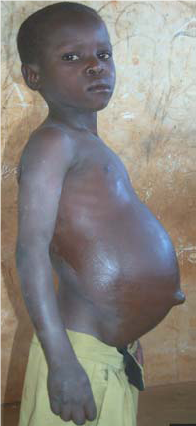FibroScHot - Impact of increased praziquantel frequency on childhood fibrosis in persistent schistosomiasis morbidity hotspots
A new EU H2020 EDCTP grant has been awarded to Cambridge University (Project Lead: Dr Shona Wilson) and the RVC (Co-Principle Investigators: Professor Joanne P. Webster and Dr Martin Walker, Senior Scientist: Dr Elsa Leger, Student Mentor: Dr James Cotton).
What is the research and why is the research necessary?
A substantial proportion of the world’s disease burden is caused by infectious agents that lead to high mortality, morbidity, and reduced productivity among many millions of people and their animals. Guided by the Millennium Development Goals (MDGs) and the subsequent Sustainable Development Goals (SDGs), much progress has been made in reducing the burden of human infectious diseases since 2000, although challenges remain and new questions emerge.
Gastrointestinal schistosomiasis caused by Schistosoma mansoni is a devastating Neglected Tropical Disease (NTD). Without control and disease management strategies, sufferers with the manifestation of periportal fibrosis can develop portal hypertension, in its severest form causing death through haematemesis. Mass Drug Administration (MDA) of the safe and efficacious drug praziquantel (PZQ) is the cornerstone of international efforts to control schistosomiasis as a public health problem. The success of such activities, in general, has in part led to a revision of WHO’s strategic plan and a vision for ‘a world free of schistosomiasis’, with elimination as a public health problem and complete interruption of transmission in selected regions by 2025.
Uganda was at the forefront of the treatment vanguard, first administering MDA in 2003. Amongst the communities first treated were those residing on the shores of Lake Albert, an area historically with high rates of periportal fibrosis. Our recent screens of school-children in these fishing communities show that despite concerted efforts and reported community treatment coverage rates of near 80%, infection intensities have remained extremely high and periportal fibrosis common, and potentially increasing, even amongst school-aged children. There is therefore a major need for alternative strategies to understand the reason for, and intervene against, these major ‘hotspots’ of infection and morbidity if the ambitious aims of the WHO and the SDG 3: “Ensure healthy lives and promote wellbeing for all at all ages” are to be met.
For rapid uptake into national and international policy these interventions need to be built upon existing control structures and be logistically easy to facilitate. In lower transmission areas, MDA is targeted at school-children, combining the epidemiological knowledge that this age-group suffers the greatest burden of infection with easier implementation. This new programme will therefore examine the impact of increased PZQ treatment frequency within the school- structure, in addition to annual community MDA. At the core of this proposal is a superiority randomised intervention trial that asks the question:
Does increased treatment frequency reduce the prevalence of childhood periportal fibrosis in hotspots of persistent schistosomiasis?
To elucidate the causes of high morbidity, in particular that distinguishing potential host from parasite, operational from biological, effects, we are incorporating a multidisciplinary range of analytical tools and measures, encompassing the host clinical, immunological and anthropological combined with parasite genomics and genetics, as well as statistical and mathematical analysis. Results will be disseminated to national, regional and international policy makers and to a multi- disciplinary NTD research community, while communication and open access data policies will ensure a wider reach.
What is the research impact?
Our FibroScHot research project is in alignment with the call specific expected impact of contribution towards Sustainable Development Goal 3 “Ensure healthy lives and promote wellbeing for all at all ages”. We have identified that we need to optimise the use of PZQ to achieve elimination of severe schistosomiasis for future generations in communities where the current standard annual treatment is failing to gain control. Result dissemination processes are in place to ensure that the proposed trial will have the widest impact possible. Capacity is being built in NTD clinical trial infrastructure, alongside support in training young Ugandan researchers in the anthropological, genomic and immunological skills that will be essential to future clinical and observational studies on NTDs within Uganda and beyond.

You may also be interested in:
-
New research from the RVC predicts the future life expectancy for companion cats
New research from the Royal Veterinary College (RVC), in collaboration with researchers from the …

